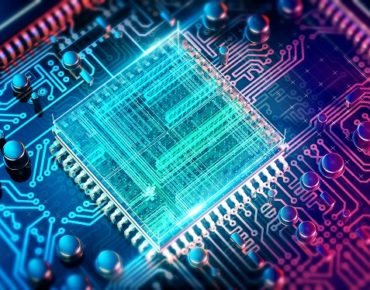Intel CFO Talks 7nm, 5nm Futures; AMD’s Growing Data Center Market Share

By its own admission, Intel’s process technology will remain a laggard for nearly two more years, not producing a 7nm CPU until late 2021, but the company expects to reestablish its process lead with a 5nm node at a later, unannounced date.
That’s the message from Intel CFO George Davis, interviewed this week during the Morgan Stanley TMT Analyst Conference, whose remarks left the impression of a company working hard to catch up with AMD, which launched its 7nm EPYC Rome server chip last summer.
Referring to its 10nm Ice Lake processor, Davis had these self-deprecating comments: “It's important that we're continuing to see yield improvements over the time period. But as we said back at our analyst day in May of 2019, look, this just isn't going to be the best node that Intel has ever had. It's going to be less productive than 14(nm), less productive than 22(nm). But we're excited about the improvements that we're seeing. And we expect to start the 7 nanometer period with a much better profile of performance over that starting at the end of 2021.”
He added that Intel is speeding up its product roadmap due to competitive pressures.
“I wanted to be clear what was happening during the 10 nanometer generation,” Davis said. “The fact is…, it isn't going to be as strong a node, as people would expect from 14(nm) or what they'll see in 7(nm). Also, we were at a time when, in order to regain process leadership, we had to accelerate the overlap between 10 and then 7 and 5. And so the cost that you're absorbing starting in particularly in 2021, you've got this intersection of a performance of 10, the investment in 7 and we're also willing to start an investment in 5, all of those elements just combined.”
 TSMC, the Taiwan-based semiconductor foundry supplier to AMD, began building a 3nm fab last year that’s expected to be in production in 2023, but whether its 3nm chip will be of the rough equivalent density of Intel’s 5 is not yet known. In any case, AMD is taking data center server processor market share from Intel, which Davis conceded is happening and gathering strength.
TSMC, the Taiwan-based semiconductor foundry supplier to AMD, began building a 3nm fab last year that’s expected to be in production in 2023, but whether its 3nm chip will be of the rough equivalent density of Intel’s 5 is not yet known. In any case, AMD is taking data center server processor market share from Intel, which Davis conceded is happening and gathering strength.
“We've said we expect to see stronger competitive dynamics in the second half of this year,” he said. “But we actually thought we would see some of that a little bit sooner. What we've seen is, again, very strong demand for our leading-edge products and not only because many of those products are customized for specific workloads. Our AI capability is particularly strong. And so we do expect there to continue to be strong demand for our products throughout this period. But we do see rising competition, we've planned for that, as we talked about in our forecasts, there will be share impacts that we’ll have to absorb. And then as we look at our product roadmap over time, we think we start to present an even more compelling competitive position as we go into 7 and 5.”
![]() Davis also shared general thoughts on the burgeoning AI market, which he expects to reach $25 billion in 2024. He said the company currently has about $4 billion in AI-related revenue, more than half from “our big Xeon processors,” along with sales of Mobileye, Intel’s vision-based technology for autonomous vehicles developed by the company’s Israel-based subsidiary, and various ASICs and FPGA accelerators.
Davis also shared general thoughts on the burgeoning AI market, which he expects to reach $25 billion in 2024. He said the company currently has about $4 billion in AI-related revenue, more than half from “our big Xeon processors,” along with sales of Mobileye, Intel’s vision-based technology for autonomous vehicles developed by the company’s Israel-based subsidiary, and various ASICs and FPGA accelerators.
“We believe it's really early days for AI and there's not going to be one technology that is the winner,” he said. “And in fact, the proliferation of AI workloads is growing fairly rapidly. What we've seen is in order to engage with customers effectively, not only do you have to have the traditional ways that people think about CPU and GPU as kind of the foundational technologies, but we're seeing…the ASIC strategy, where you can basically have a programmable ASICs focused on delivering either inference-type solutions or training solutions, but in a way that gives the customer more control over how they approach that.”
Another source of pressure on Intel is delivery in 2021 of the Aurora exascale supercomputer to Argonne National Lab, a system that will incorporate Intel’s 10nm++ Sapphire Rapids CPUs and 7nm Xe GPUs. How delivery of Aurora could be impacted by Intel’s road map delays and missed deadlines is not known, but Intel did not ship an earlier, pre-exascale system to Argonne that had been scheduled for delivery in 2018.
Davis’s comments come during a period of significant change at Intel, including turnover in its senior management team that began in June 2018 with the firing of former CEO Brian Krzanich, coinciding with AMD’s re-emergence as a potent price/performance foe. We reported last week on the departure of Naveen Rao, corporate VP/GM of Intel’s AI Platforms Group. In January, it was learned that AMD had hired Daniel McNamara, formerly Intel’s president and GM of the Network and Custom Logic Group, to be SVP/GM of AMD’s Server Business Unit. And last November, we reported on the retirement of Rajeeb Hazra, corporate VP of Intel’s Data Center Group and GM for the Enterprise and Government Group.










